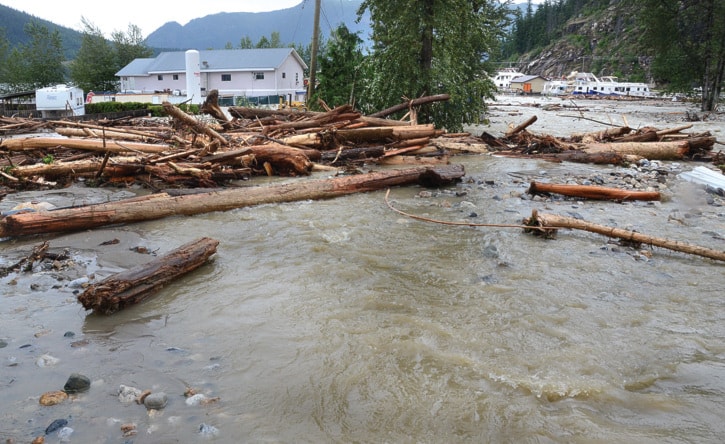A Sicamous houseboat company is urging the City of Salmon Arm to undertake a flood hazard and risk assessment sooner than later.
Last week, Salmon Arm city council received a presentation from Bill Remphrey and George Zorn on behalf of WA:TER (Wetland Alliance: The Ecological Response), entitled Living on a Flood Plain. The crux of the talk revolved around the city’s need for an assessment to help minimize the risks involved should flooding occur.
The presentation included Zorn reading a letter from Waterway Houseboats chief operating officer Neil Millar, who was unable to attend the meeting.
In the letter, Millar relays what the company went through in June 2012 when Sicamous Creek swelled into a debris flow, which nearly devastated the business and caused substantial financial stress.
“We had to evaluate how and whether we would be able to continue to operate and, of course, do an unbelievable amount of work to get open again. The emotional strain was not helped by the virtual lack of assistance offered by all levels of government,” states Millar. “The costs to our company in terms of stress and financial loss have been staggering and, quite frankly, nearly sunk our company. The toll is in the millions of dollars.”
Millar goes on to say that Waterway has launched a “compelling case regarding the liability surrounding our damages,” and have launched a claim against the Crown, the District of Sicamous and others.
“I would simply say that analyzing your flood plain and taking the necessary preventive measures proactively would be the only responsible way to proceed.”
Salmon Arm council has also received a letter from Community Futures Shuswap executive director Joanne Mason, on behalf of chair (and Sicamous councillor) Charlotte Hutchinson, asking the city address the need for a flood hazard and risk assessment in the 2014 budget.
“We recognize the health of individual businesses and the region as a whole could be significantly impacted should adequate steps not be taken to better understand and mitigate our flood plain risk,” says Mason in an email to the News. “Our organization sees this advanced planning as simply another step in ensuring the ongoing vibrancy and health of businesses in our region.”
Remphrey spoke to historical flooding in the area, including the 2012 flooding in Sicamous and a benchmark-setting flood that occurred in Salmon Arm in 1894.
“Piccadilly Mall and the fairgrounds have all been under water, and many homes and businesses would be as well if this happened again, and it could happen again and it will happen again and maybe even worse,” said Remphrey, who went on to comment on the stress and financial loss that could occur, and how there is no insurance available in Canada for overland flooding. In addition, Canadian insurance companies want flood zone maps updated to take into account the increasing trend of extreme weather resulting from climate change. Remphrey noted how the BC Real Estate Association recently put together an action plan, Planning to Avoid Disaster, intended to push for the updating of floodplain maps in the province.
“In the meantime, since there’s no current insurance for overland floods in Canada, our only insurance really, is to try and get as much information as we can, and use this information such as flood plain maps to come up with preventive measures,” said Remphrey.
Council has allocated $20,000 towards an assessment in the city’s 2014 budget. Development services director Kevin Pearson said this was a big first step towards an assessment, which he estimated will cost $80,000.
Coun. Ken Jamieson said that now there is money set aside, he hoped staff would be active in pursuing grant money to help offset the cost. Though the assessment is listed as a medium-term priority in the city’s strategic plan (to be done between 2018 and 2020), Jamieson emphasized he too would like to see it happen next year.
Zorn offered WA:TER’s support in finding the city possible grant funding, and explained a preliminary flood risk assessment was undertaken by BGC Engineering in 2011, and that the city is already in possession of that information.
“That could be leveraged as part of the total cost, although there was a non-disclosure agreement that this is confidential in terms of competitors if you were to tender it out,” said Zorn.
